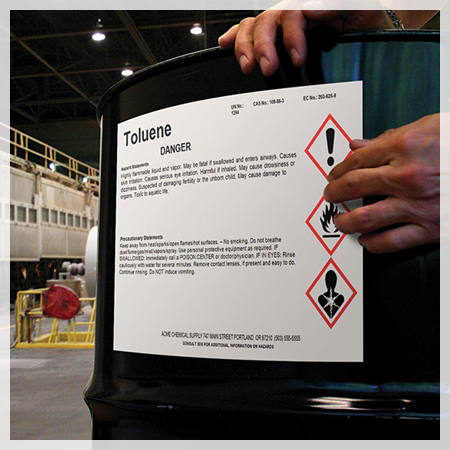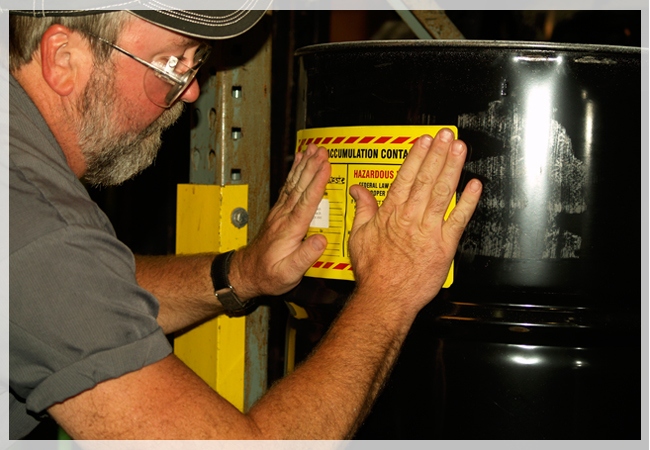Currency
October 15, 2017

Each year, hazard communication (HazCom) is among OSHA’s most-cited violations. The chemical safety rules described in OSHA’s HazCom 2012 regulations were originally based on the United Nations’ Globally Harmonized System (GHS) to create a consistent and practical approach. Since then, all HazCom 2012 deadlines have passed, and the latest update of GHS took effect in 2015, yet employers continue to struggle with identifying and communicating hazards posed by dangerous chemicals.
Fortunately, chemical manufacturers, suppliers, shippers, and handlers can take steps toward complying with HazCom 2012 and GHS standards with simple, effective visual communication tools.
HazCom regulations were designed to protect employees, improve communication, and simplify the complex steps needed for safety in chemical manufacturing, shipping, storage, and use.
Here’s how that happens:
-- Boosts communication: More than 60 countries have adopted GHS, which means suppliers, manufacturers, and shipping companies are all on the same page and draw on the same visual communication elements to stay safe.
-- Improves efficiency: With the standardized system for communicating hazards, risks, and mitigation techniques, workers don’t have to take time to figure out new systems, forms, or labels.
-- Saves money: Companies don’t have to spend money on additional supplies or worker training to comply with various standards in different countries.

GHS, created and published by the United Nations, provides a standardized method for identifying and communicating chemical hazards around the world. Some countries have implemented GHS unchanged, while others tweaked the system to suit their specific needs. In the United States, OSHA used GHS as the basis for HazCom 2012, its updated Hazard Communication Standard, but made a few subtle tweaks. Those changes reflect specific hazards, de-emphasize compliance with British Standard 5609 for saltwater exposure, and remove size requirements for diamonds surrounding pictograms on shipping labels.
A visual communication system that complies with HazCom 2012 requirements contains two essential elements: Safety Data Sheets and container labels.
The first such requirement is a Safety Data Sheet (SDS), similar to the Material Safety Data Sheets in earlier editions of the HazCom rules. This essential document covers relevant information about a given chemical, along with solutions for staying safe in the event of an accident.
The SDS is a standardized document that creates a cohesive, uniform method for communicating that information. Each SDS is broken down into 16 sections, which are as follows:
1. Identification identifies the hazardous material and its intended applications.
2. Hazard Communication provides the material’s Hazard Class and Category, as well as related information that conveys the dangers posed by a material, including the Signal Word, Hazard Statement(s), Pictogram(s), and Precautionary Statement(s) that will appear on the label.
3. Composition/Information on Ingredients describes the chemical makeup of a material, as well as any ingredients that contribute to a mixture’s chemical hazards.
4. First Aid Measures document the basic first-aid procedures in case of an accident.
5. Fire-fighting Measures explain the appropriate fire-fighting tactics, as well as hazards that might arise if the material burns.
6. Accidental Release Measures explain how to respond to spills, leaks, or other releases of the material.
7. Handling and Storage provides any applicable instructions for safely handling or storing the material.
8. Exposure Controls/Personal Protection identifies the necessary controls for using the material and PPE to be worn.
9. Physical and Chemical Properties describe the material’s characteristics, including color, odor, flammability, and so on.
10. Stability and Reactivity informs workers whether a material poses any reactivity or chemical instability hazards—and offers steps and conditions for mitigating those hazards.
11. Toxicology Information includes information about potential health hazards posed by the material.
12. Ecological Information explains the material’s potential impact on the environment, as well as ecological properties, including degradability and environmental toxicity.
13. Disposal Consideration explains the steps for properly disposing, recycling, or reclaiming a material or its ingredients.
14. Transportation Information provides information (such as instructions or classifications) that might impact transportation of a given material.
15. Regulatory Information provides information about relevant domestic or international regulations, as well as instructions or details for meeting those regulations.
16. Other Information communicates any other information that may prove useful or helpful.
Employers in the United States aren’t required to publicly display an SDS, but must always have updated and correct SDSs on hand and readily available.
The second essential element of a GHS or HazCom 2012-compliant visual communication system is a container label, which communicates — in a standardized, clear format — the basic, essential information about a given material’s hazards.
There are no specific size requirements for a container label except that it must be clear and easy to see. For labels used only within a facility, there are some additional options, but each label for containers that are shipped or transported elsewhere must include six elements, each building upon its corresponding SDS entry.
The six “building blocks” of a fully detailed, HazCom 2012-compliant label are as follows:
1. Product Identifier and Code identifies which chemical is being labeled (using the chemical name, rather than a brand name) and provides the CAS, EC, and/or UN number assigned to that chemical (when applicable).
2. Pictogram(s) communicate a material’s hazards through symbols within red diamonds. The necessary symbols are determined by a material’s Hazard Classes and Categories.
3. Signal Word communicates the severity of a material's hazards (determined by the hazard’s class and category) through two signal words: "Danger" is reserved for the most severe hazards, while "Warning" is for less severe hazards. Suppliers may choose to leave this field blank when a chemical's hazards are minor.
4. Hazard Statement(s) are simple, consistent phrases that communicate the specific hazards posed by a material. These are found in section 2 of a chemical's SDS.
5. Precautionary Statement(s) provide instructions for avoiding, mitigating, or responding to specific hazards.
6. Supplier Identification includes the name, address, and telephone number of the material’s supplier.
Fortunately, chemical manufacturers, suppliers, shippers, and handlers can take steps toward complying with HazCom 2012 and GHS standards with simple, effective visual communication tools.
How HazCom keeps you safe
HazCom regulations were designed to protect employees, improve communication, and simplify the complex steps needed for safety in chemical manufacturing, shipping, storage, and use.
Here’s how that happens:
-- Boosts communication: More than 60 countries have adopted GHS, which means suppliers, manufacturers, and shipping companies are all on the same page and draw on the same visual communication elements to stay safe.
-- Improves efficiency: With the standardized system for communicating hazards, risks, and mitigation techniques, workers don’t have to take time to figure out new systems, forms, or labels.
-- Saves money: Companies don’t have to spend money on additional supplies or worker training to comply with various standards in different countries.

HazCom standards
GHS, created and published by the United Nations, provides a standardized method for identifying and communicating chemical hazards around the world. Some countries have implemented GHS unchanged, while others tweaked the system to suit their specific needs. In the United States, OSHA used GHS as the basis for HazCom 2012, its updated Hazard Communication Standard, but made a few subtle tweaks. Those changes reflect specific hazards, de-emphasize compliance with British Standard 5609 for saltwater exposure, and remove size requirements for diamonds surrounding pictograms on shipping labels.
HazCom visual communication requirements
A visual communication system that complies with HazCom 2012 requirements contains two essential elements: Safety Data Sheets and container labels.
Safety Data Sheet
The first such requirement is a Safety Data Sheet (SDS), similar to the Material Safety Data Sheets in earlier editions of the HazCom rules. This essential document covers relevant information about a given chemical, along with solutions for staying safe in the event of an accident.
The SDS is a standardized document that creates a cohesive, uniform method for communicating that information. Each SDS is broken down into 16 sections, which are as follows:
1. Identification identifies the hazardous material and its intended applications.
2. Hazard Communication provides the material’s Hazard Class and Category, as well as related information that conveys the dangers posed by a material, including the Signal Word, Hazard Statement(s), Pictogram(s), and Precautionary Statement(s) that will appear on the label.
3. Composition/Information on Ingredients describes the chemical makeup of a material, as well as any ingredients that contribute to a mixture’s chemical hazards.
4. First Aid Measures document the basic first-aid procedures in case of an accident.
5. Fire-fighting Measures explain the appropriate fire-fighting tactics, as well as hazards that might arise if the material burns.
6. Accidental Release Measures explain how to respond to spills, leaks, or other releases of the material.
7. Handling and Storage provides any applicable instructions for safely handling or storing the material.
8. Exposure Controls/Personal Protection identifies the necessary controls for using the material and PPE to be worn.
9. Physical and Chemical Properties describe the material’s characteristics, including color, odor, flammability, and so on.
10. Stability and Reactivity informs workers whether a material poses any reactivity or chemical instability hazards—and offers steps and conditions for mitigating those hazards.
11. Toxicology Information includes information about potential health hazards posed by the material.
12. Ecological Information explains the material’s potential impact on the environment, as well as ecological properties, including degradability and environmental toxicity.
13. Disposal Consideration explains the steps for properly disposing, recycling, or reclaiming a material or its ingredients.
14. Transportation Information provides information (such as instructions or classifications) that might impact transportation of a given material.
15. Regulatory Information provides information about relevant domestic or international regulations, as well as instructions or details for meeting those regulations.
16. Other Information communicates any other information that may prove useful or helpful.
Employers in the United States aren’t required to publicly display an SDS, but must always have updated and correct SDSs on hand and readily available.
The building blocks of a container label
The second essential element of a GHS or HazCom 2012-compliant visual communication system is a container label, which communicates — in a standardized, clear format — the basic, essential information about a given material’s hazards.
There are no specific size requirements for a container label except that it must be clear and easy to see. For labels used only within a facility, there are some additional options, but each label for containers that are shipped or transported elsewhere must include six elements, each building upon its corresponding SDS entry.
The six “building blocks” of a fully detailed, HazCom 2012-compliant label are as follows:
1. Product Identifier and Code identifies which chemical is being labeled (using the chemical name, rather than a brand name) and provides the CAS, EC, and/or UN number assigned to that chemical (when applicable).
2. Pictogram(s) communicate a material’s hazards through symbols within red diamonds. The necessary symbols are determined by a material’s Hazard Classes and Categories.
3. Signal Word communicates the severity of a material's hazards (determined by the hazard’s class and category) through two signal words: "Danger" is reserved for the most severe hazards, while "Warning" is for less severe hazards. Suppliers may choose to leave this field blank when a chemical's hazards are minor.
4. Hazard Statement(s) are simple, consistent phrases that communicate the specific hazards posed by a material. These are found in section 2 of a chemical's SDS.
5. Precautionary Statement(s) provide instructions for avoiding, mitigating, or responding to specific hazards.
6. Supplier Identification includes the name, address, and telephone number of the material’s supplier.









